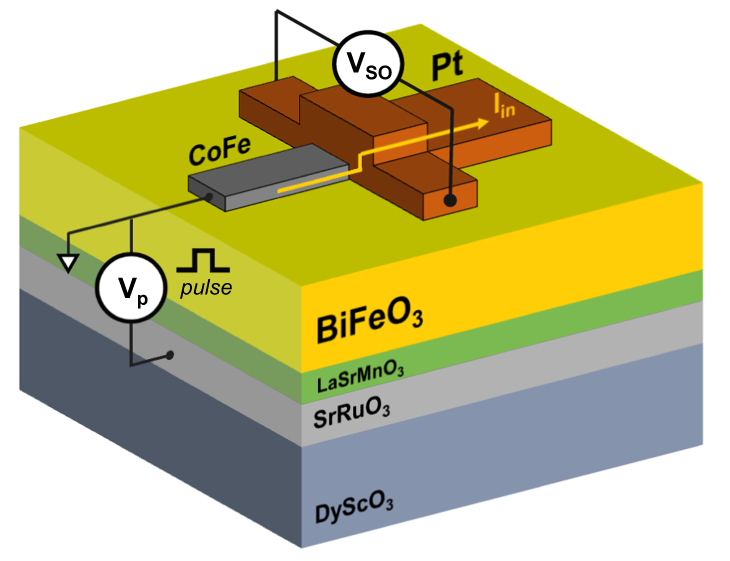The building block for magnetoelectric spin-orbit logic
Complementary metal–oxide–semiconductor (CMOS) is a type of metal–oxide–semiconductor field-effect transistor (MOSFET) fabrication process that uses complementary and symmetrical pairs of p-type and n-type MOSFETs for logic functions. CMOS technology is used for constructing integrated circuit chips, including microprocessors, microcontrollers, memory chips, and other digital logic circuits. After 50 years of continuous transistor size downscaling and increased performance, future iterations of logic circuits will require beyond-CMOS alternatives that explore new physical effects through non-conventional materials.
While Moore’s law – the number of transistors that can be placed on an integrated circuit doubles every two years – is still sustained by increasingly complex transistor designs and lithography advances, the last decade saw a clear breakdown of Dennard’s scaling, where smaller transistors no longer mean smaller operational voltages, compromising the energy efficiency and performance of future chips. In recent years, a flurry of new logic devices has emerged, driven by the usage of alternative state variables, such as spin, polarization, strain, and orbital.
Among these options, spin-based solutions have shown tremendous promise and applicability. Owing to their non-volatile nature, effects like spin-transfer torque and spin–orbit torque brought major improvements in stand-by power, as well as in terms of endurance, writing speed, and compatibility with back-end of line fabrication processes. Yet, controlling magnetization states using these methods still requires rather large currents, preventing their usage as a realistic non-volatile logic solution.
Alternatively, voltage-based methods gained some traction in recent years, mainly pushed by voltage-controlled magnetic anisotropy (VCMA), where voltage-induced dynamic switching of magnetization has been reported. While field-free VCMA writing has been recently shown, further work is required to improve the VCMA coefficient, in order to bring this technology closer to product applications.
A pathway for field-free voltage-based switching of magnetism has been proposed using magnetoelectric materials that exhibit more than one of the primary ferroic properties in the same phase. Among several possible combinations, the coexistence of ferroelectricity and ferromagnetism is expected to allow the control of magnetization through switching of the ferroelectric polarization with an electric field. In this category, BiFeO3 has been the most studied material, exhibiting a tight coupling between antiferromagnetic and ferroelectric orders at room temperature.
The road to multiferroic-based devices has been long and tortuous, with sparse results reported. Yet, it is expected that such devices can bring magnetization writing energies down to the attojoule range, an improvement of several orders of magnitude when compared with state-of-the-art current-based devices. This driving force led to the recent proposal of magnetoelectric spin–orbit (MESO) logic, suggesting a spin-based nanodevice adjacent to a multiferroic, where the magnetization is switched solely with a voltage pulse and is electrically read using spin-to-charge current conversion (SCC) phenomena.

Now, a team of researchers demonstrates 1 the experimental implementation of such a device. The team fabricates SCC nanodevices on BiFeO3 and analyze the reversibility of the magnetization of ferromagnetic CoFe using a combination of piezoresponse and magnetic force microscopy, where the polarization state of the BiFeO3 and the magnetization of CoFe are imaged upon switching.
The researchers then correlate this with all-electrical SCC experiments where voltage pulses are applied to switch the BiFeO3, reversing the magnetization of CoFe (writing) and different SCC output voltages are measured depending on the magnetization direction (reading).
The results support voltage-based magnetization switching and reading in nanodevices at room temperature, enabled by exchange coupling between multiferroic BiFeO3 and ferromagnetic CoFe, for writing, and spin-to-charge current conversion between CoFe and Pt, for reading. Upon the electrical switching of the BiFeO3, the magnetization of the CoFe can be reversed, giving rise to different voltage outputs. Through additional microscopy techniques, magnetization reversal is linked with the polarization state and antiferromagnetic cycloid propagation direction in the BiFeO3.
While further work is required in terms of controllability and reproducibility of the switching, specifically regarding the ferroelectric and magnetic textures in BiFeO3, these results provide a key step forward toward voltage-control of magnetization in nanoscale magnets, essential for future low-power spin-based logic and memory devices. Thus, this study constitutes the building block for magnetoelectric spin-orbit logic, opening a new avenue for low-power beyond-CMOS technologies.
Disclaimer: Parts of this article have been copied verbatim or almost verbatim from the referenced research paper.
References
- Diogo C. Vaz, Chia-Ching Lin, John J. Plombon, Won Young Choi, Inge Groen, Isabel C. Arango, Andrey Chuvilin, Luis E. Hueso, Dmitri E. Nikonov, Hai Li, Punyashloka Debashis, Scott B. Clendenning, Tanay A. Gosavi, Yen-Lin Huang, Bhagwati Prasad, Ramamoorthy Ramesh, Aymeric Vecchiola, Manuel Bibes, Karim Bouzehouane, Stephane Fusil, Vincent Garcia, Ian A. Young & Fèlix Casanova (2024) Voltage-based magnetization switching and reading in magnetoelectric spin-orbit nanodevices Nature Communications doi: 10.1038/s41467-024-45868-x ↩